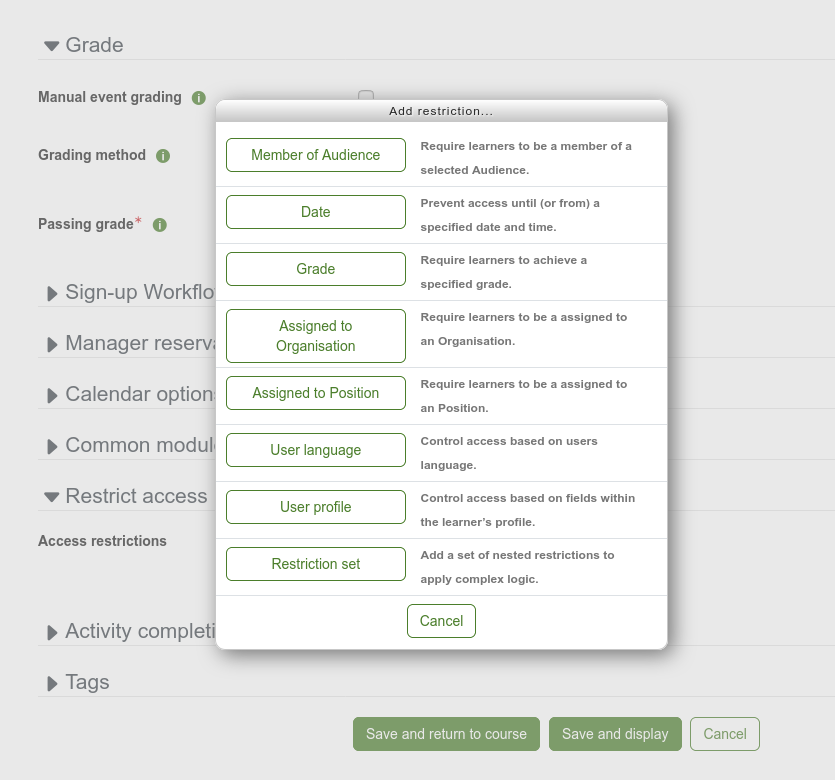Hi! Can someone share where it makes better practice to use tenants vs audiences? We have various departments, contract workers, etc. and audiences seem to make sense but wondering whether tenants would be better? What would be some criteria to make the designation?
Totara Learn Open Discussions
Tenants vs audiences
Hi Barbara,
We have some guidance on this in our Multitenancy course which you might find useful. There is actually a diagnostic activity in that course designed to help you identify which solution may be most appropriate based on your needs - which covers both multitenancy and audiences. Some of the questions you might want to think about are:
- Do you need to delegate user/content management within these groups?
- Do you need a clear separation between these groups of users or would it be OK if they saw each other in shared spaces?
- Do you want to apply different themes / login pages for different groups?
We also have some overview documentation in our Help docs, starting with What is multitenancy?
I hope that helps - do let us know what you decide - or feel free to post back here with more specific requirements and other Community users may be able to share their advice!
Hi Rachel
I was interested to read Barbara's question as I have a similar issue.
I've just watched the guidance on multitenancy courses but I'm still a little confused about whether it's best to use Audiences or Multitenancy for our situation and I wondered if you could let me have your thoughts please?
We run the same course, for different groups of users, starting on different dates. The problem we have is that regardless of whether a user is on week 1 or week 7 of a course, they can see all of the material for all weeks as it's open to everyone because of the different start dates.
In the situation described above, would you think it best to use Multi tenancies?
Thanks for your help.
Karen
Hi Karen & Barbara,
Hopefully I can provide some useful recommendations here :)
Based on what you've described I don't think a multi-tenancy set up would be needed. It seems to me that using a combination of audiences and then restricting access to certain activity content within the course would probably give you what you need.
Audiences provide a simple way to group users into different categories and then do things like enrol them in learning. Once you have audiences set up you can later view reports and apply an audience based filter to only show users who are in that particular audience. A simple option to do this is to create a set audience of users each time a new group of learners joins the system.
Audiences can also be designed to have automated dynamic rules. This "Dynamic" type of audience lets new members automatically join and leave based on a rule or collection of rules. These audience rules can be based on an aspect of a user's job assignment (e.g organisation, position, manager) a profile preference (e.g city, country, language preference etc) or even based on whether they have/have not completed another piece of learning. To read more about this check out the help docs for some examples. Whether you use set or dynamic audiences is up to you, but either option will simplify processes, allow easy bulk user actions and reduce the time it takes to perform day-to-day tasks across the system.
The second part of your query in your example you mention that you have groups of users needing to access courses at different dates. There are a couple of ways you could manage this dependent on how much the course changes:
If you have a course that is made up of multiple core activity modules (i.e. activities that all users need to access/complete regardless of the date they join) and also a smaller number of activities or resources that are specific to a certain group (audience), I'd suggest using Restricted Access. This may first need to be enabled globally in Learn Settings (Site Administration > Configure Features > Learn Settings).
Once enabled you can then go to a course, turn on editing and click to Edit Settings for any activity or resource and apply an Access Restriction. There are multiple options and either a applying either a Date based restriction or a Member of Audience restriction are suitable approaches. Both have same effect of allowing you to set some content in the course to be only visible to certain users (and restricted to others).

If alternatively, the majority of the content in the course is changing and there are large differences in criteria between what one audience of users needs to complete, compared to another audience enrolling at a different time - I'd probably suggest it's better to create an entirely new course. You could backup the old course and then restore it as a template to make this process quicker.
Hopefully this gives you some ideas about getting this set up, let us know if you have other questions,
Cheers,
Tom